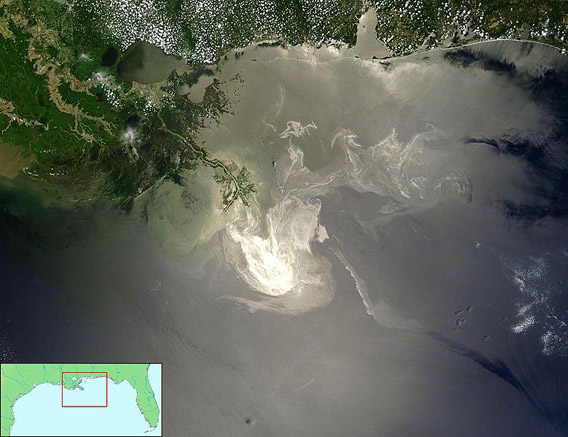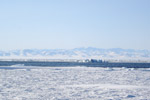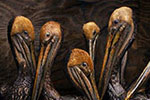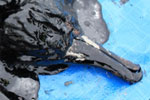
BP Deepwater Horizon oil spill as seen from space. Photo by: NASA’s Terra Satellite.
Two years after the BP-leased Deepwater Horizon drilling rig exploded in the Gulf of Mexico, killing eleven and causing an oil spill that lasted three months, scientists say the impacts on the Gulf ecosystem are only beginning to come to light and the discoveries aren’t pretty.
An investigative report in Al Jazeera has detailed horrific mutations in Gulf wildlife, which may be connected to the 4.9 million barrels of oil that spilled in 2010 and the 2 million gallons of chemical dispersant used on the spill by oil giant BP, whose initials stem from its former name of British Petroleum. Scientists and fishermen told investigative reporter, Dahr Jamail, of fish covered in lesions, shrimps lacking eyes and eye sockets, and crabs without claws.
In some regions, fishermen said half the shrimp they were catching were coming up eyeless, while a recent study found that fish lesions jumped from occurring on 0.1 percent of the fish caught to 2-5 percent after the oil spill. In some areas, however, fish with lesions made up 20-50 percent of those sampled. Al Jazeera was told over and over again that scientists and fishermen had never seen anything like this.
Killifish, a vital prey species, has also been hit hard by the oil spill.
“What we found is a very clear, genome-wide signal, a very clear signal of exposure to the toxic components of oil that coincided with the timing and the locations of the oil,” Andrew Whitehead, a biology professor with Louisiana State University, told Al Jazeera. He noted in a video with the news organization that the killifish’s “hearts aren’t forming properly.”
Scientists add that it appears overall biodiversity is down in the Gulf since the oil spill, a clear indicator of a degraded ecosystem.
Despite the unusual number of abnormalities found by scientists and fishermen, the U.S. government remains largely silent regarding the concerns. The Food and Drug Administration (FDA) and the Environmental Protection Agency (EPA) told Al Jazeera to seek comment from the National Oceanic and Atmospheric Administration (NOAA), but the NOAA said it would not comment because it is collecting information for ongoing litigation against BP.
For BP’s part, the oil giant has long been argued that the Gulf of Mexico was recovering quickly from the oil spill, even though pollution from past oil spills have taken years to make their way up the food chain and many oil-spill regions have not fully recovered after decades.
“Seafood from the Gulf of Mexico is among the most tested in the world, and, according to the FDA and NOAA, it is as safe now as it was before the accident,” BP told Al Jazeera.
But, the narrative that the impacts of the oil spill on the Gulf’s ecosystem has been mild has long been challenged. Hundreds of dead dolphins and aborted babies have been found since the disaster with many researchers linking the rise in dolphin moralities to the oil spill. Researchers note that the number of dolphins and whales killed by the disaster could be as much as 50 times higher than the bodies found. In addition, scientists have fingerprinted BP oil on deep sea coral ecosystems, resulting in a mass-death of corals.
Despite the disaster, deep sea oil drilling in the Gulf of Mexico is ongoing. Meanwhile the Obama Administration has given preliminary go-ahead to offshore oil exploration in the Arctic, where critics say dealing with a Deepwater Horizon-like oil spill would be next to impossible due to seasonal ice, extreme weather, and a lack of infrastructure.
The US consumes more oil than any other country in the world. In 2010 the US consumed an estimated 19.1 million barrels of oil everyday (6.9 billion annually). For decades the US has focused on producing and importing more oil, instead of increasing efficiency, lowering consumption, and new technologies.
Related articles
Deepwater oil spill likely to hurt fish populations over decades
(09/28/2011) Oil pollution doesn’t have to kill fish to have a long-term impact, according to a recent study in the Proceedings of the National Academy of Sciences (PNAS). Researchers found that Gulf killifish (Fundulus grandis) that had been exposed to very low to non-detectable levels of oil contamination from the Deepwater oil spill last year, still showed developmental problems that are likely to impact fish populations for decades to come.
Obama Administration, Shell moving ahead with Arctic oil exploitation

(04/02/2012) Last week, the U.S. Department of the Interior approved oil spill clean-up plans by Royal Dutch Shell Oil in the Beaufort Sea, paving the way for offshore oil drilling in the Arctic to begin as soon this year. The Interior’s approval was blasted by environmentalists, who contend that oil companies have no viable way of dealing with a spill in the icy, hazardous conditions of the Arctic, far from large-scale infrastructure. Shell, which has spent $4 billion to date to gain access to the Arctic, must still be granted final permits for drilling.
Photos: pelicans covered in BP oil wins top wildlife photo prize

(10/20/2011) Fittingly, the winner of the 2011 Veolia Wildlife Environment Photographer of the Year award captured the shock of last year’s BP Deepwater Horizon spill in the US with a single image of oiled pelicans huddled in a rescue center. Spanish photographer, Daniel Beltra, was documenting the environmental impacts of the spill with Greenpeace, for whom he has worked for 15 years. The photo was taken in a temporary rescue facility in Fort Jackson, Louisiana.
Photos: New Zealand oil disaster kills over 1200 birds to date

(10/16/2011) According to the New Zealand government an oil spill from a grounded container ship in the Bay of Plenty has killed 1,250 seabirds with hundreds of others in rescue centers. However, conservationists say the avian death-toll is far higher with most contaminated birds simply vanishing in the sea. “The number of birds being found washed up on the beaches will be a very small proportion of the birds being affected,” explained Karen Baird, Seabird Conservation Advocate with NGO Forest & Bird.
US approves first deepwater drilling in Gulf since BP disaster as oil tar balls reappear on coast
(03/22/2011) Yesterday the US Bureau of Ocean Energy Management, Regulation and Enforcement awarded Royal Dutch Shell PLC the first deep-water exploration permit since the BP disaster last year, which sent some 4.9 million barrels of oil and up to 500,000 tons of methane into the Gulf of Mexico over three months.
Dead baby dolphins washing ashore in Gulf of Mexico
(02/28/2011) Every year a few baby dolphins in the Gulf don’t make it and are found on the shores of the Gulf, but this year something is different. To date, 24 baby dolphins have been found dead in Alabama and Georgia, some are stillborn, others aborted fetuses. Researchers, who say death-toll is ten times the average, are currently studying the dead porpoises for clues to cause. These could include colder-than-average waters, algal blooms, disease, or the incident in the back of everyone’s mind: the BP oil spill last year.
Gulf of Mexico bottom still coated in oil, recovery long way off
(02/21/2011) Samantha Joye of the University of Georgia has seen the bottom of the Gulf of Mexico and the view wasn’t pretty. Speaking at the American Association for the Advancement of Science, Joye told the conference that she found places where oil lay on the Gulf floor nearly 4 inches (10 centimeters) thick. Joye’s findings contradict rosier pictures of the overall damage caused by the 2010 BP oil spill, including a recent statement by Kenneth Feinberg, the US government czar for oil compensation, that the Gulf would largely recover by next year.